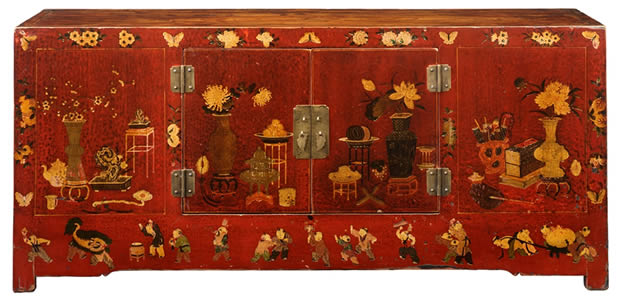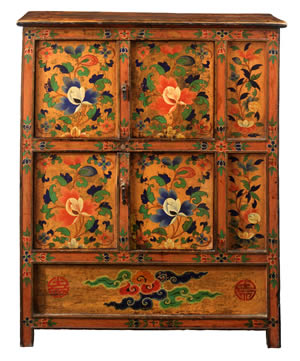
Painted furniture and a favourite piece
This week I wanted to talk about one of my favourite features of antique Chinese furniture – the beautiful decorative paintings often found on pieces from central and western provinces such as Shanxi and Qinghai.
Pieces generally have a base coat of black or red, with hand-painting in gold and other colours. This ‘gold-painting’ technique is known as ‘miao jin’ and reached the height of its popularity during the Ming dynasty. Good examples of original miao jin are becoming increasingly hard to find, due to poor conservation, daily wear and tear and over enthusiastic ‘restoration’.
The red sideboard pictured below was found on a recent trip to China. It’s dated around 1900 and is from the western province of Qinghai. It’s typical of the type of furniture I would expect to find here: usually in red or black lacquer and brightly painted.

The flower vases, bronzes and books painted on the doors are fairly standard designs for this type of piece and were supposed to denote the importance or ‘scholarly’ status of the owner. The butterflies around the frame are symbols for long life and marital happiness and are also fairly typical. The figures on the bottom apron are much more unusual – I’m not entirely sure what they represent and would be happy to hear the knowledge of any readers on this!
I loved this particular sideboard so much that we took many of the images from the paintings to create a series of limited edition prints, available on the website.
 Another favourite whose paintings also feature in our prints was this beautiful cabinet from Tibet. Because there was virtually no consumer class in Tibet during the 19th century to demand luxury goods such as fine furniture, almost all pieces from the region originated in the monasteries, made by and for the monks.
Another favourite whose paintings also feature in our prints was this beautiful cabinet from Tibet. Because there was virtually no consumer class in Tibet during the 19th century to demand luxury goods such as fine furniture, almost all pieces from the region originated in the monasteries, made by and for the monks.
Tibetan furniture is usually made from pine – the most readily available material – and the pieces have a distinctive style, being brightly painted with designs usually including flowers or religious imagery. The paintings were produced using natural pigments, which tend to fade over time.
Tibetan furniture in its original state, without any retouching to the paintings, is now becoming quite rare and as a result these pieces are becoming more and more expensive. You’ll find some pieces on our website at shimu.co.uk (both the pieces featured here have been sold).





Leave a comment